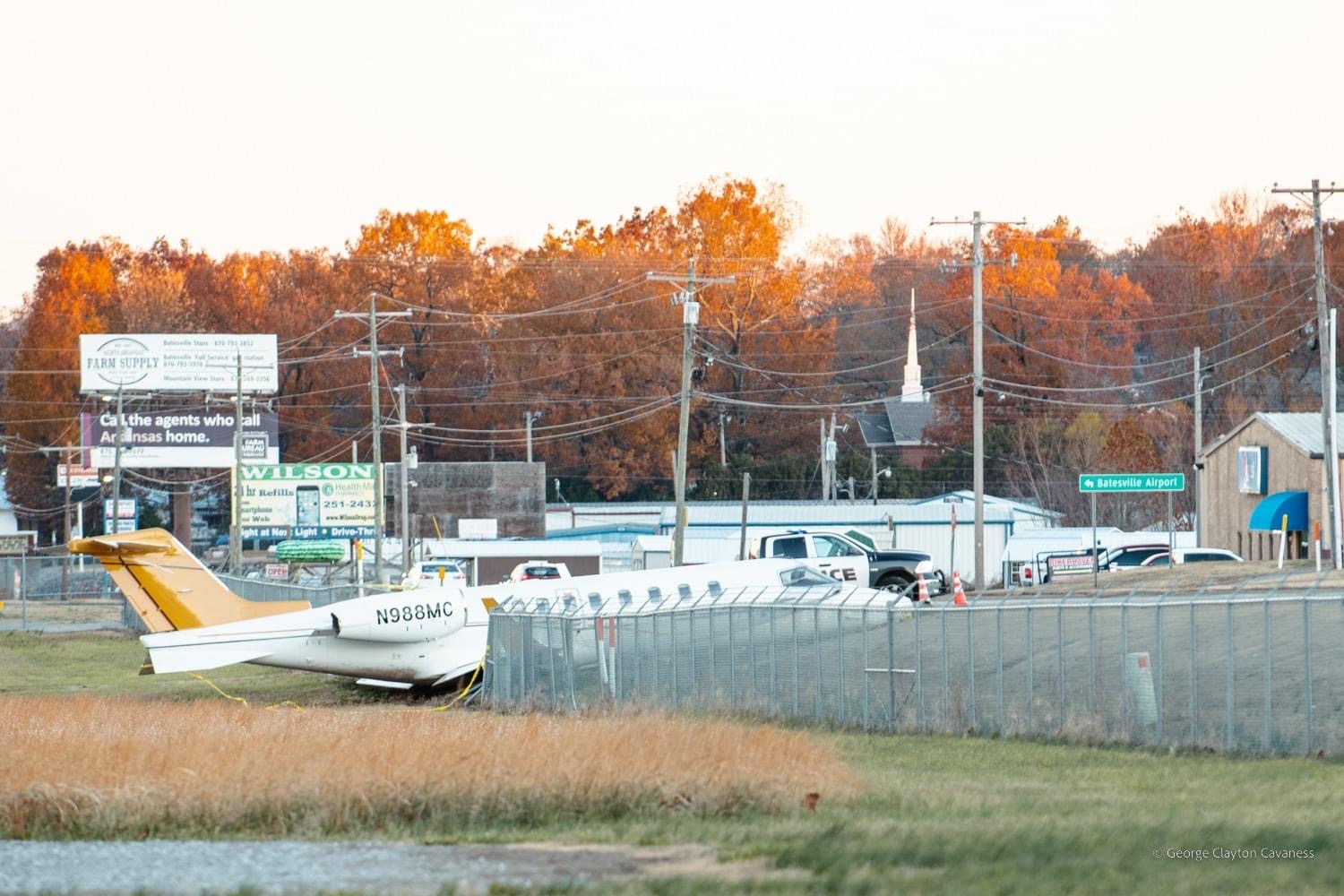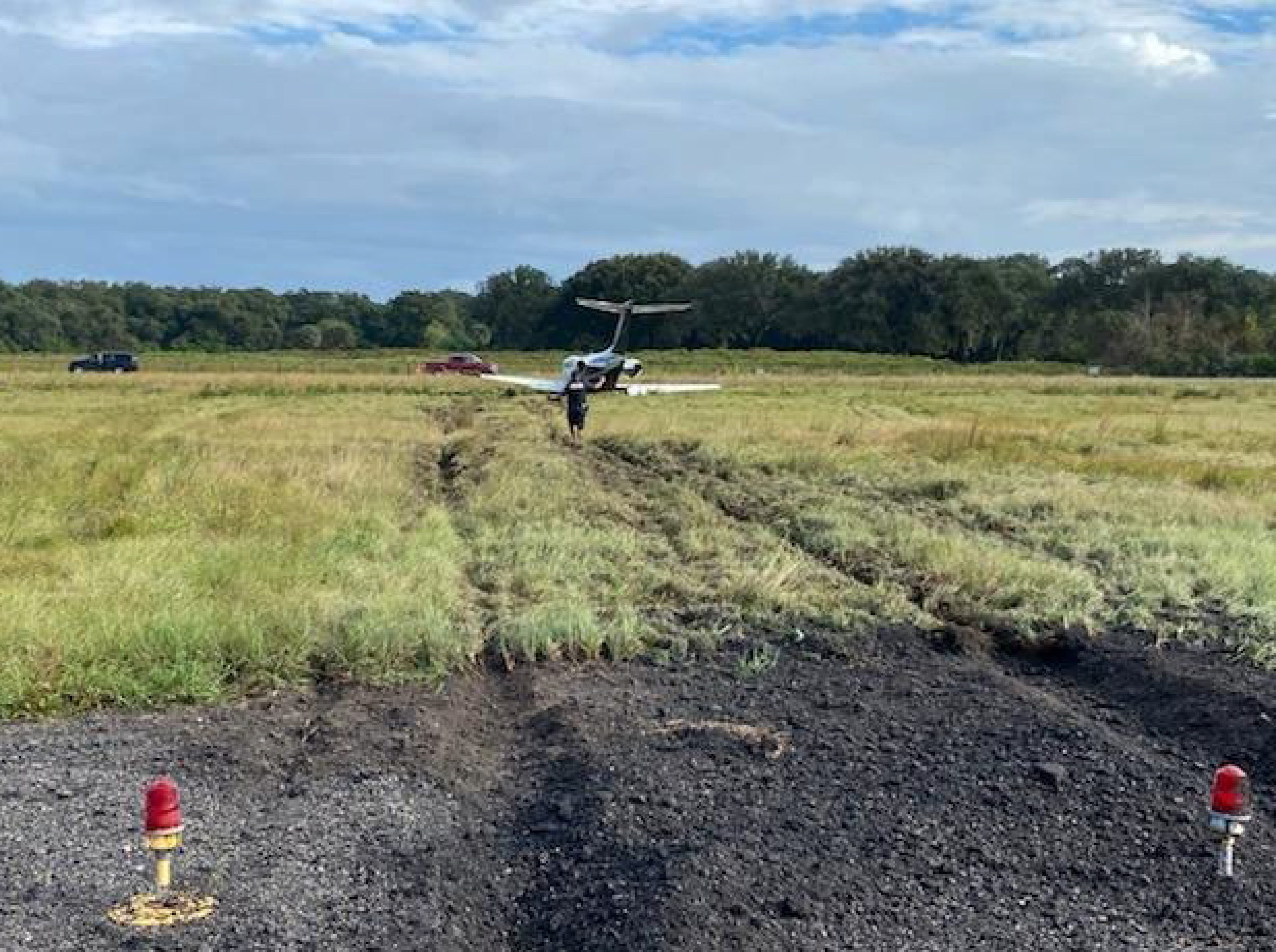There are many things we professional aviators hold sacred. We have so many commandments that we must follow, it might be helpful to list “the” ten commandments for aviators, but there are far more than ten.
— James Albright

Updated:
2023-01-15
I’ve noticed lately that smaller, older jets seem to have more transgressions than in larger, newer jets. Looking at the last two years might provide a few clues on how to fix what is broken. So here are nine such accidents that caught my attention, from the most recent going back two years. Each accident violates a commandment we aviators should hold dear; they all violate the tenth.
1 —Thou shall not abort a takeoff above V1 unless the aircraft will not fly.
2 —Thou shall make all approaches, including circling approaches, stable.
4 —Thou shall respect the weather.
5 —Thou shall know thine aircraft and thyself.
6 —Thou shall back up all visual approaches with instruments when available, especially at night.
8 —Thou shall obey all aircraft limitations.
9 —Thou shall not take maintenance shortcuts.
10 —Thou shall fly as if thine own family is onboard.
Other commandments
Or course these are not "the" ten commandments of aviation, just the ones that came up in this two year search of small business jets. I can think of many more, some of which I would place above the ones listed before.
- Thou shall treat thy fellow crewmembers as you would like to be treated.
- Thou shall treat thy Airplane Flight Manual as sacred.
- Thou shall brief all takeoffs, departures, approaches, and landings.
- Thou shall not make idle conversation during critical phases of flight.
- Thou shall not skip a checklist.
- Thou shall not ignore tire pressures.
- Thou shall not fail to remove all contamination from thine aircraft prior to flight.
- Thou shall not ignore an EGPWS or TCAS alert.
- Thou shall not ignore another pilot's abort or go around call.

1
Thou shall not abort a takeoff above V1 unless the aircraft will not fly.
During the takeoff roll, [the PIC] heard “one boom” and one second later called V1, which is the maximum speed at which a rejected takeoff can be initiated in the event of an emergency. At the same time, he called “V1” the PIC noted a second “boom” and the second-in-command, who was the pilot flying, called to abort the takeoff. The PIC reported to air traffic control that they were aborting the takeoff with a suspected blown tire. They attempted to slow the airplane, but the there was no braking action.
Extracted from: NTSB ERA23LA075
Predictably, this didn't end well.
They were unable to stop and the aircraft continued off the runway. There were no injuries but the aircraft was substantially damaged. While the investigation continues, pilots should remember two things about this situation:
First, it is clear the PIC correctly perceived they had a blown tire, perhaps two. Calling an abort for blown tires at high speed is unlikely to succeed since you will need those tires to be in good shape to do that.
Second, the V1 call needs to be made early enough so it has been already spoken and understood by the time you reach the speed. If you say "Vee one" at that speed, it is too late.
More about this: V1.
Summary:
- Aircraft Registration: N12FN
- Aircraft Type: Learjet 36
- Date: 30 November 2022
- Airport: Newport News / Williamsburg International Airport (KPHF), Newport News, VA
- Result: 0 fatalities, aircraft substantially damaged
- NTSB Case Number: ERA23LA075
2
Thou shall make all approaches, including circling approaches, stable.
During the arrival to BVX, a non-towered airport, the air traffic controller cleared the airplane for the RNAV (GPS) Rwy 8 approach and the crew canceled IFR after visually acquiring the runway environment. The airplane crossed the final approach fix at 265 knots ADS-B groundspeed and the Runway 8 threshold at 190 knots ADS-B groundspeed.
Extracted from: NTSB CEN23LA056
Predictably, this didn't end well.
The runway was wet and the airplane landed about 2,000 feet past the threshold of the 6,022 foot runway. Tire marks consistent with intermittent brake application started about 3,021 feet from the end of the runway. The airplane exited the runway at 100 knots ADS-B groundspeed. Both pilots sustained minor injuries, the six passengers were uninjured, but the fuselage sustained substantial damage.
Crossing the threshold at 190 knots is about right for the space shuttle but much too high for a Learjet. It is a primary consideration for what makes for a stable approach. More about this: Stabilized Approach.
Summary:
- Aircraft Registration: N988MC
- Aircraft Type: Learjet 45
- Date: 29 November 2022
- Airport: Batesville Regional Airport (KBVX), Batesville, AR
- Result: 0 fatalities, aircraft substantially damaged
- NTSB Case Number: CEN23LA056
3
Thou shall always land in the touchdown zone; if the touchdown has not occurred once the touchdown zone is passed, thou shall go around.
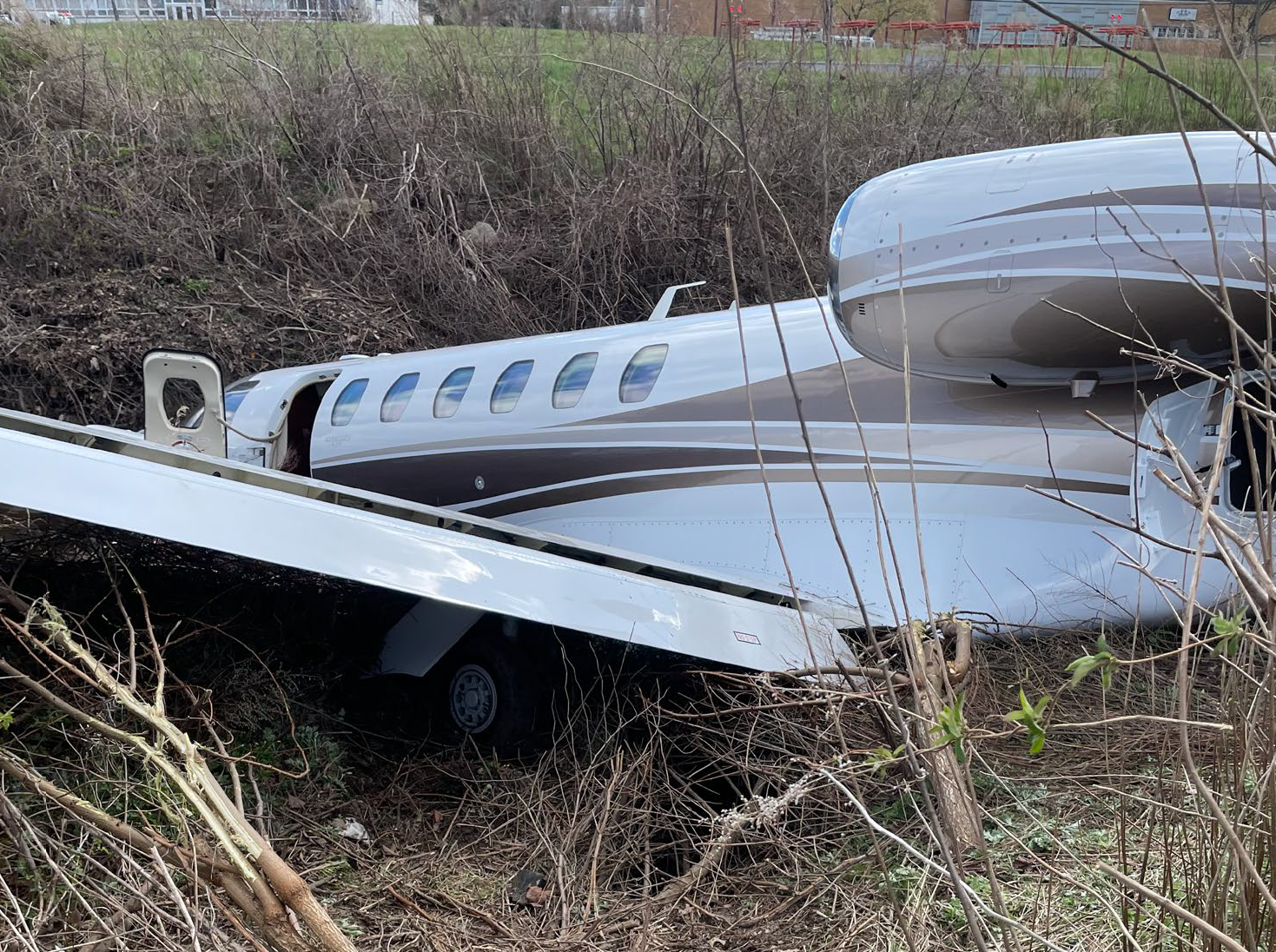
N225SC, (Photo: NTSB ERA22LA190)
The pilot-in-command (PIC) of the business jet described that at the conclusion of the flight the second-in-command (SIC) would conduct the landing. The SIC briefed the approach and the PIC agreed. The tower cleared the airplane for the visual approach to runway 22 (4,552-ft long), noting winds were 300° at 18 knots, gusting to 26 knots. The PIC told the SIC that if he did not feel comfortable with the approach to landing, he should voice his concern, and initiate a go-around or transfer control of the airplane to the PIC. The PIC also briefed the procedure for taking control of the airplane should any unsafe conditions be observed.
The PIC further described that after turning final, the landing checklist was completed, and "the airplane was established on a stabilized approach." The SIC noted that he would fly at a slightly higher speed due to varying winds and gusts. Just before touchdown, the airplane “encountered a gust of wind that resulted in a ground effect float.” The airplane then touched down “at Ref speed” and on what the PIC perceived to be the first third of the runway.
Review of airport surveillance camera footage showed that the airplane touched down beyond the midpoint of the runway.
Extracted from: NTSB ERA22LA190
Predictably, this didn't end well.
The PIC's point that the airplane was established on a stabilized approach can be interpreted to mean once that item is checked, it is no longer a concern. Of course, this is wrong. You must continuously evaluate the progress of the approach and the landing to ensure all requirements for a stabilized approach are met, including landing in the touchdown zone. There were no injuries, however the aircraft was damaged beyond repair. Post crash analysis determined the aircraft needed 2,652 feet to stop from a 50-foot threshold crossing height. Touching down at the midpoint of this runway wasn't going to work. Once again, this violates one of the criteria for calling an approach stabilized. More about this: Stabilized Approach.
Summary:
- Aircraft Registration: N225SC
- Aircraft Type: Textron Aviation 525B (CitationJet CJ3)
- Date: 17 April 2022
- Airport: Caldwell Wright Airport, (KCDW), New Jersey
- Result: 0 fatalities, aircraft damaged beyond repair
- NTSB Docket: ERA22LA190
4
Thou shall respect the weather.
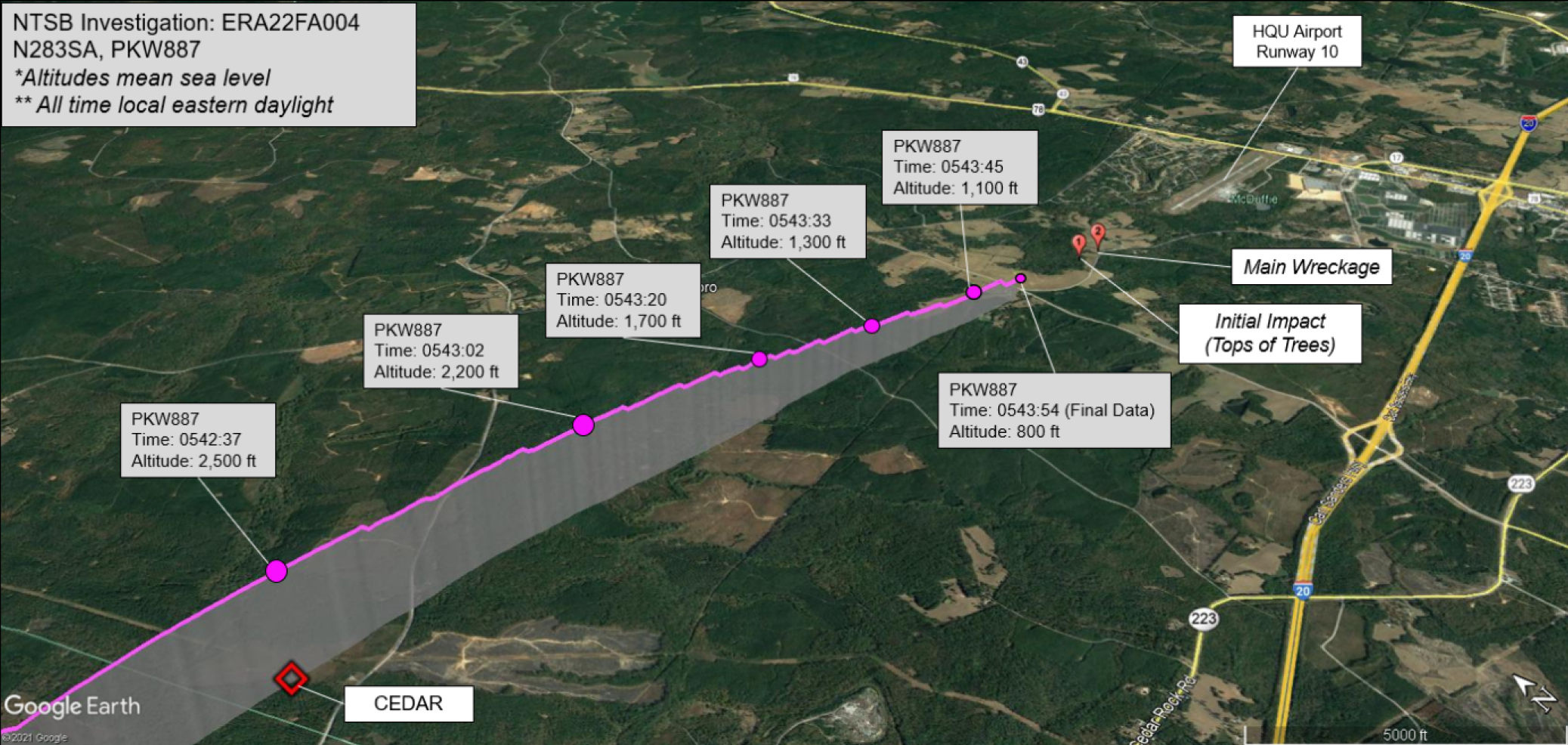
N283SA flight track, NTSB ERA22FA004, figure 1
At 0503 eastern daylight time, Pak West Flight 887 (PKW887) requested information about the Notices to Airman (NOTAMs) for the instrument landing system (ILS) localizer runway 10 instrument approach procedure at HQU. ATL Center informed the flight crew of two NOTAMs; the first pertained to the ILS runway 10 glide path being unserviceable and the second applied to the localizer being unserviceable. The controller informed the flight crew that the localizer NOTAM was not in effect until later in the morning after their expected arrival, which was consistent with the published NOTAM.
About 0525, ATL center asked PKW887 which approach they would like, to which they responded with the “ILS runway one zero approach.” The controller responded, “roger, standby for that.”
About 0537, ATL center informed PKW887 that they were 15 miles southwest from CEDAR and “cross CEDAR at or above 3,000 cleared ILS localizer one zero into Thomson McDuffie."
Review of preliminary FAA Automatic Dependent Surveillance – Broadcast (ADS-B) data revealed that the airplane crossed CEDAR intersection about 2,500 ft mean sea level (msl), which was 500 feet below their cleared altitude. The airplane continued toward runway 10 in a descent; the final data recorded was at 0543:54 with the airplane at 800 ft msl and 1.36 nautical miles from the runway threshold.
Extracted from: NTSB ERA22FA004
Predictably, this didn't end well.
Their descent from CEDAR to ground impact was at a fairly constant rate, around 1,500 feet per minute. This was more than double what you would expect for an ILS or a Continuous Descent Final Approach (CDFA). This was also about fifty percent higher than the descent you would expect on a conventional "dive and drive" non-precision approach.
There have been many cases where pilots expected an ILS with localizer and glide slope, were told the glide slope was out of service, and then proceeded to fly what they thought was a glide slope. In some cases they flew an expected VVI, in others they latched onto another instrument. This investigation continues, but it appears these pilots flew something other than a glide slope and were both killed.
Summary:
- Aircraft Registration: N283SA
- Aircraft Type: Dassault Falcon 20C
- Date: 5 October 2021
- Airport: Thomson-McDuffie County Airport, (KHQU), GA
- Result: 2 fatalities, aircraft damaged beyond repair
- NTSB Preliminary Report: ERA22FA004
5
Thou shall know thine aircraft and thyself.
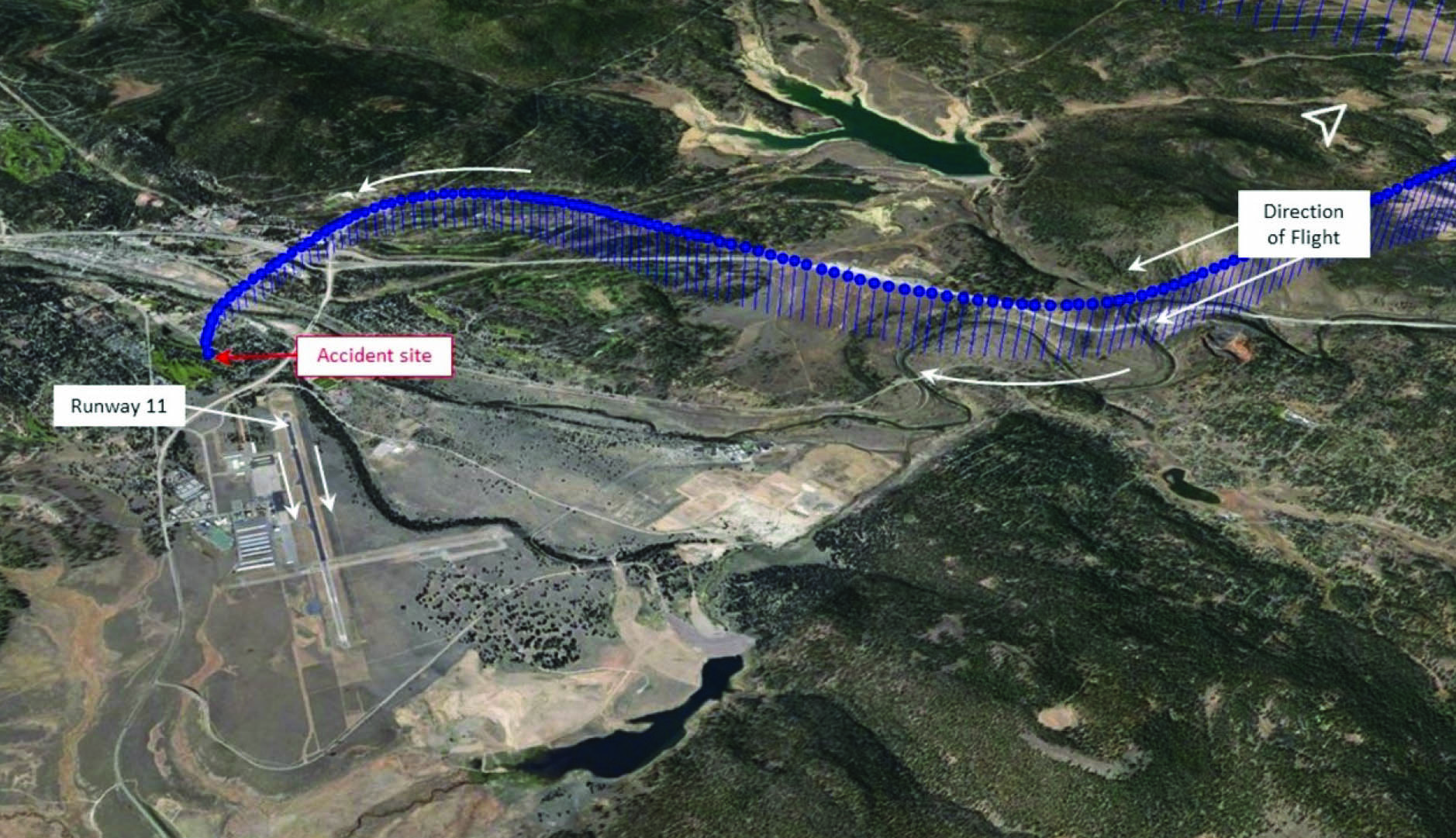
Flight track, NTSB WPR21FA286
Before we get to the Cockpit Voice Recorder (CVR) for the case of Challenger 605 N605TR at Truckee Airport, California (KTRK) on July 26, 2021, some context. The Pilot In Command (PIC) was also the Pilot Flying (PF) and had 235 hours in Challengers, most of that in the older Challenger 601. The Second In Command (SIC) was the Pilot Monitoring (PM), was a contract pilot, and was highly experienced with well over 4,000 hours in Challengers. The PF shot the KTRK RNAV (GPS) 20, attempted to circle to Runway 11.
13:17:12.6 (PM) we don't wanna be on the news.
13:17:14.8 (PM) autothrottles have it.
13:17:17.8 (PM) you are looking very good my friend.
13:17:24.1 (PM) nice and relaxed...bring that turn around.
13:17:24.3 (Cockpit Mike) sound similar to increase in engine rpm
13:17:27.5 (PM) perfect.
13:17:30.2 (PM) it's okay...you got plenty of time.
13:17:33.6 (PM) let it keep comin' down though.
13:17:41.4 (Cockpit Mike) one thousand. [electronic voice]
13:17:42.7 (PM) did you? oh you turned the throttles off...
13:17:43.5 (Cockpit Mike) [sound similar to altitude alert]
13:17:44.4 (PF) yes.
13:17:44.6 (PM) shoot (expletive)
13:17:46.4 (PM) let me see the airplane for a second.
13:17:51.6 (Cockpit Mike) sound similar to decreasing engine rpm
13:17:54.7 (PM) we're gonna go through it and come back okay?
13:17:56.8 (PF) okayyy . . .
13:18:00.4 (PF) It's here. [exclamation]
13:18:01.4 (PM) yes yes it's here but we are very high.
13:18:03.6 (Cockpit Mike) sink rate. [electronic voice]
13:18:04.2 (Cockpit Mike) sounds similar to stick shaker activation
13:18:04.2 (PF) what are you doing?
13:18:04.2 (Cockpit Mike) pull up. [electronic voice]
13:18:04.5 (PM) ‘kay.
13:18:04.8 (PF) (unintelligible word)
13:18:04.9 (Cockpit Mike) warbler sound consistent with stall warning
13:18:05.0 (PM) no no no.
13:18:06.2 (PM) let-
13:18:06.5 (PF) what are you doing?
13:18:06.6 (Cockpit Mike) pull up. [electronic voice]
13:18:06.6 (PM) let me have the airplane.
13:18:07.3 (PM) let me have the airplane.
13:18:07.9 (Cockpit Mike) sounds similar to stick shaker activation
13:18:07.9 (Cockpit Mike) warbler sound consistent with stall warning, continues throughout the end of the recording
13:18:08.0 (Cockpit Mike) pull up. [electronic voice]
13:18:08.6 (PM) let me have the airplane.
13:18:09.4 (Cockpit Mike) pull up. [electronic voice]
13:18:09.7 (PF) oh. [exclamation]
13:18:10.0 (PM) oh (expletive)
13:18:10.8 (PF or PM) (expletive)
13:18:11.0 (Cockpit Mike) pull-- [electronic voice]
13:18:11.3 (Cockpit Mike) (sounds consistent with impact)
13:18:12.2 End of recording
Extracted from: NTSB WPR21FA286, Cockpit Voice Recorder, Group Chairman's Factual Report
Predictably, this didn't end well.
The PF attempted to circle from too high an altitude and too close to the runway. The PM saw this but didn't know how to forcefully intervene. Neither pilot understood the slow speed flying characteristics of their aircraft, how their aircraft stalls, and how quickly it can all happen.
Lesson One: Circling in real life is not what you are taught to do in the simulator. More about this: Circling Approach.
Lesson Two: Crew Resource Management (CRM) is not simply a matter of being nice to each other, it is a tacit contract that says, "We agree not to kill each other." More about this: Crew Resource Management.
Lesson Three: What you practice in the simulator is not an aerodynamic stall, it is the approach to an aerodynamic stall. You need to understand how your aircraft stalls to really appreciate the need to avoid that. More about this: Low Speed Flight and Stall Recovery.
Summary:
- Aircraft Registration: N605TR
- Aircraft Type: Bombardier CL-600-2616 Challenger 605
- Date: 26 July 2021
- Airport: Truckee Airport, (KTRK), CA
- Result: 3 fatalities, aircraft damaged beyond repair
- NTSB Docket: WPR21FA286
6
Thou shall back up all visual approaches with instruments when available, especially at night.
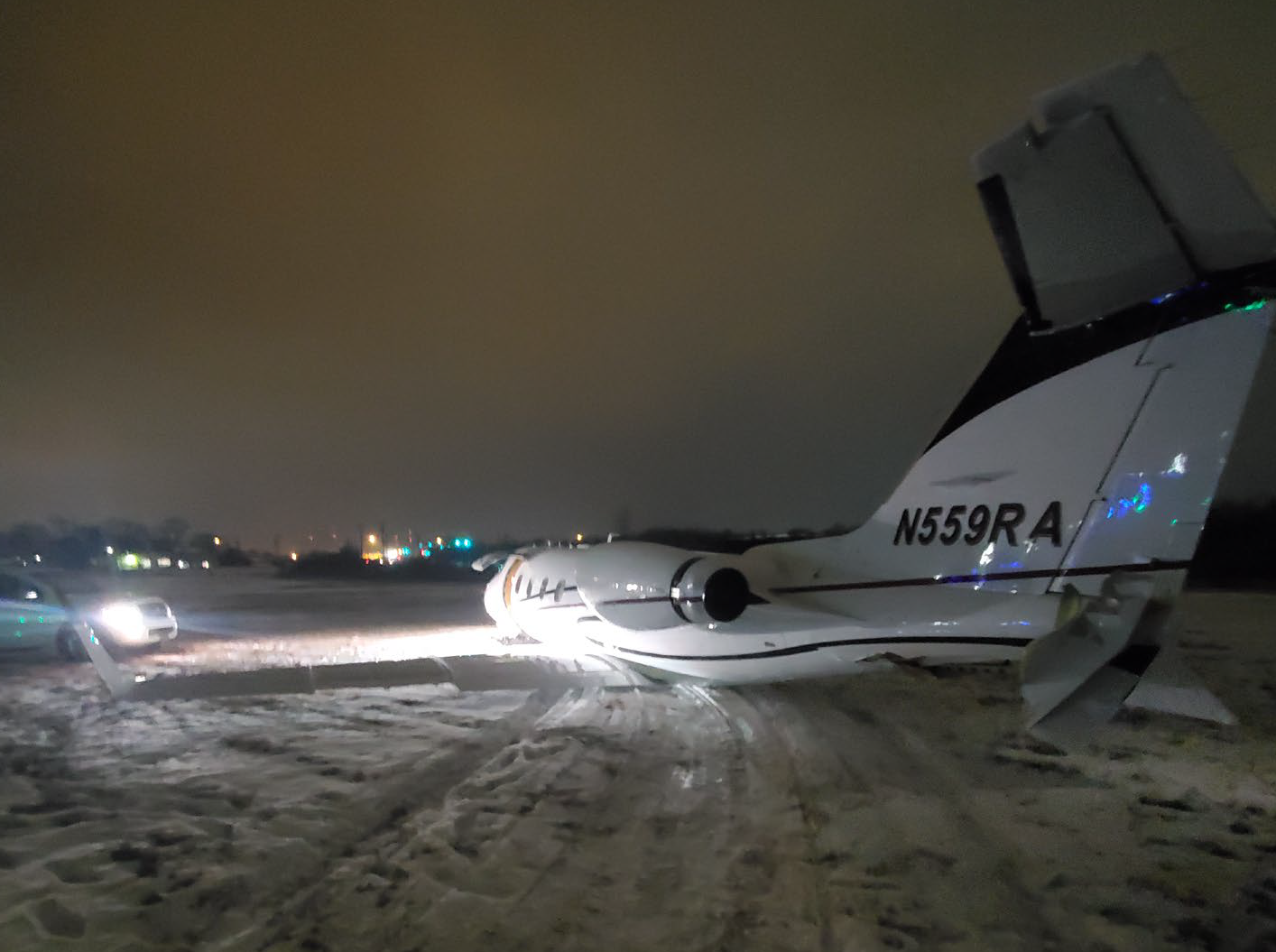
N559RA, NTSB CEN21LA136
Runway 32 was closed due to a large amount of snow that was in the process of being cleared. About 4 inches of snow remained. The runway lights were on at the time of the accident to aid the snowplow operators in determining the location of the runway edge; however, there were no plows on runway 32 at the time of the accident. The lights for runway 36 may not have been visible due to the snow berms along the runway edge obstructing their view from the side.
Both pilots reported that, as they approached the airport, they saw runway lights and set up for a visual approach to that runway. They believed the runway they saw was runway 36, but it was in fact runway 32, which had been closed due to snow. A notice to airman had been published to that effect. In addition, the airport’s automated weather observing system recording was appended with the runway closure information. The pilots continued the approach and landed on runway 32.
Extracted from: NTSB CEN21LA136
Predictably, this didn't end well.
The aircraft stuck a snow berm at the edge of the intersection with runway 36, the landing gear broke from the airplane, and the airplane slid to a stop. There were no injuries, but the aircraft was substantially damaged.
This is an age-old problem that has had an easy solution that is getting easier with technology: never make a visual approach without a instrument backup, if available. That is getting easier to do with the proliferation of GPS approaches and avionics that allow a visual approach to be backed up by cockpit avionics. This goes beyond setting up the back up, but also referencing it throughout the visual approach. More about this: Wrong Airport
Summary:
- Aircraft Registration: N559RA
- Aircraft Type: Learjet 55C
- Date: 18 February 2021
- Airport: Jefferson-Clark Regional Airport, (KJVY), IN
- Result: 0 fatalities, aircraft substantially damaged
- NTSB Docket: CEN21LA136
7
Thou shall obey minimums.
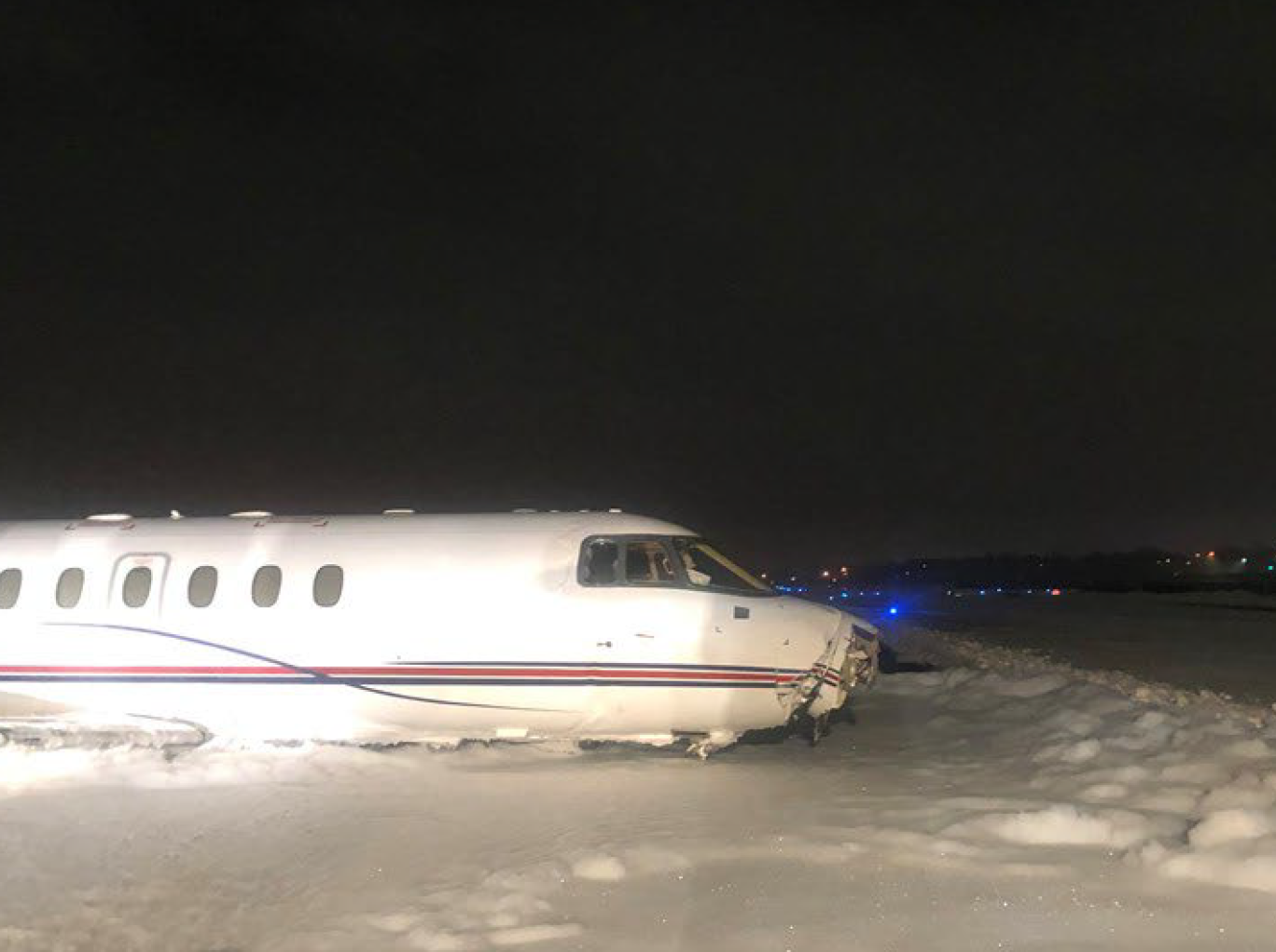
N412JA, NTSB ERA21LA083
The flight crew were conducting an instrument landing system (ILS) approach in night instrument meteorological conditions when they were advised by the tower controller that the weather had deteriorated below minimums. The captain was the pilot monitoring, and the first officer was the pilot flying during the approach. Since the airplane was inside the final approach fix and stabilized, both pilots agreed to continue with the approach.
Extracted from: NTSB ERA21LA083
Predictably, this didn't end well.
Both pilots said they had visual contact with the runway approach lighting system at the 200 ft decision altitude, but the first officer said he then returned to flying the airplane via instruments. As the first officer continued the approach, the captain told him the airplane was drifting right of the runway centerline. The first officer said that he looked outside, saw that the weather had deteriorated, and was no longer comfortable with the approach. The first officer said he pressed the takeoff and go-around switch, while at the same time, the captain called for a go around. Although both pilots stated that the go-around was initiated when the airplane was about 50 to 100 ft agl, the cockpit voice recorder (CVR) recording revealed that the first officer flew an autopilot-coupled approach to 50 ft agl (per the approach procedure, a coupled approach was not authorized below 240 ft agl). As the airplane descended from 30 to 20 ft agl, the captain told the first officer three times to “flare” then informed him that the airplane was drifting to right and he needed to make a left correction to get realigned with the runway centerline. Three seconds passed before the first officer reacted by trying to initiate transfer control of the airplane to the captain. The captain did not take control of the airplane and called for a go around. The first officer then added full power and called for the flaps to be retracted to 15º; however, the airplane impacted the ground about 5 seconds later, resulting in substantial damage to the fuselage. Both pilots were injured.
It is incredibly hard to correctly identify a runway at minimums but we somehow do it in the simulator during training without fail. We rarely get a chance in the airplane, but when that happens, things usually turn out. This reinforces our thinking that it is routine. So if tower says the weather is below minimums, why not look a little lower? These pilots kept the airplane coupled down to 50 feet, perhaps thinking the automation would get them there even if they didn't really see what they needed to see. Those electrons are awfully good, right?
Assuming the aircraft is calibrated perfectly, that the localizer antenna is calibrated perfectly, and that there is nothing interrupting the localizer beam, you need to have the localizer wired to just a tenth of full scale deflection, about a needle width of the CDI. More about this: Instrument Landing System/Good Enough?. Those are a lot of assumptions when the outcome is life or death.
Summary:
- Aircraft Registration: N412JA
- Aircraft Type: Raytheon Hawker 800XP
- Date: 20 December 2020
- Airport: Farmingdale-Republic Airport, (KFRG), NY
- Result: 0 fatalities, aircraft substantially damaged
- NTSB Docket: ERA21LA083
8
Thou shall obey all aircraft limitations.
The air taxi flight departed in visual meteorological conditions. Upon arrival in the area of the destination airport, the flight crew of the business jet encountered instrument meteorological conditions and precipitation as a trough passed through the area. During the downwind leg of the instrument approach to runway 13, the copilot checked the automated surface-reported wind, which was from 110° at 4 knots gusting to 18 knots. Audio from the airplane’s cockpit voice recorder showed that, as the crew continued the approach, the copilot twice commented to the pilot that the actual wind for the approach was a tailwind (which he likely observed on the airplane’s primary/multi-function displays), at one point noting that the tailwind was more than 20 knots. The flight crew nonetheless continued the instrument approach, and after visually identifying the runway at a height of about 300 feet above the ground, landed the airplane.
Data downloaded from the airplane’s flight data recorder showed that the airplane touched down at a groundspeed exceeding 120 knots, about 10 knots faster than the airplane’s reference approach airspeed (Vref). After the airplane touched down, the pilot believed that there was a problem with the airplane’s brakes, as he received “zero feedback” despite his attempts to slow down. During the landing the copilot deployed the airplane’s speed brakes for about 6 seconds before retracting them, about the time he commented to the pilot that they should abort the landing. The pilot declined to abort and directed the copilot to deactivate the airplane’s anti-skid system with about 1/3 of the available runway remaining.
Extracted from: NTSB ERA21LA036
Predictably, this didn't end well. The airplane departed the end of the runway and came to rest above 150 feet beyond the runway end. There was one minor injury and the aircraft was substantially damaged.
Post accident investigation showed no evidence of preaccident mechanical malfunctions or failures. The runway was wet and there was a "substantial tailwind." The investigation concluded the following as causal: "The flight crew's improper decision to land with a tailwind on a wet runway, which resulted in a runway overrun. Contributing to the accident was the copilot’s early retraction of the speed brakes and the pilot’s decision to turn off the anti-skid system."
Summary:
- Aircraft Registration: N456FL
- Aircraft Type: Learjet 36
- Date: 1 November 2020
- Airport: Newport News / Williamsburg International Airport, (KPHF), VA
- Result: 1 minor injury, aircraft substantially damaged
- NTSB Docket: ERA21LA036
9
Thou shall not take maintenance shortcuts.
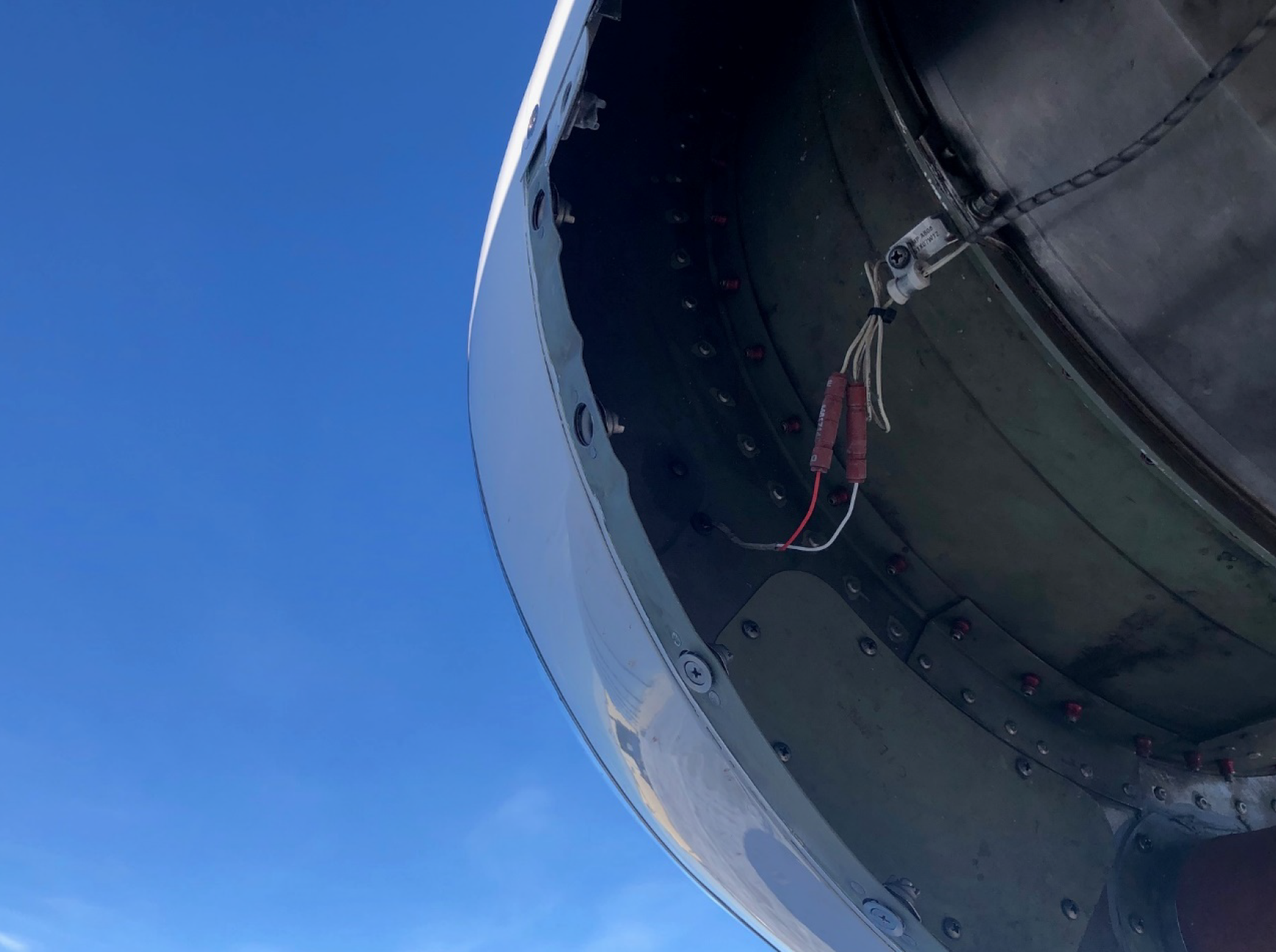
CGOJG, the missing cowl, NTSB ERA19FA248
Several fasteners used to secure the right engine cowl were -4 studs, which were 0.03 inch longer than the other (-3) fasteners. The aircraft manufacturer’s drawings and the Illustrated Parts Catalog (IPC) for the engine lower cowl door indicated only -3 studs. Longer studs would allow for increased grip length, which would induce protrusion and misalignment of the engine cowl with adjacent structure. In addition, Skybolt grommets were used in the fastener assembly to secure the right engine lower cowl on the accident airplane; Skybolt grommets have a greater height than those cited in the IPC and the airplane manufacturer’s drawing, and, per these sources, Skybolt was not an approved vendor for the fastener assembly. The use of taller grommets would have also caused the cowl to protrude and be out of alignment with adjacent structure.
Extracted from: NTSB ERA19FA248
Predictably, this didn't end well. The airplane was in cruise flight at FL 250 when it experienced a separation of the right engine cowl, which struck and substantially damaged the right horizontal stabilizer and elevator. The airplane landed at the destination airport without further incident. Postaccident examination of the airplane found that two fasteners located at the forward inboard corner of the right engine lower cowl and a third fastener (which joined the right engine upper and lower cowls) were missing. The cowling and three fasteners were not recovered. There were no injuries, but the aircraft was substantially damaged.
More about this: Maintenance Malpractice.
Summary:
- Aircraft Registration: CGOJG
- Aircraft Type: Cessna 525A, CitationJet CJ2
- Date: 18 December 2019
- Airport: Scotts Bluff-Western Nebraska Regional Airport (KBFF), Nebraska
- Result: No injuries, aircraft substantially damaged
- NTSB Docket: ERA19FA248
10
Thou shall fly as if thine own family is onboard . . .
. . . and they are all NTSB board members.
It has almost become trite to recommend a pilot for a job by saying, "I wouldn't hesitate letting my family fly with this pilot." I've also heard that the key to being a safe pilot is to always fly as if your family is on board. I'm not sure how useful all this is, but taken in the context of the previous nine commandments, perhaps we can figure out if there are any common threads to help us going forward.
Common threads?
In each of these accidents, I doubt any of the people found to be causal would have failed a training event prior to the crash. "Would you abort a takeoff after V1?" Of course not. "If you haven't touched down by the time the touchdown zone is behind you, what would you do?" Of course, you would go around. And so on.
It isn't that we flying larger business jets haven't had the same problems, but we seem to have fewer of them. The fact larger and newer jets have more built-in redundancies may have saved many from the same fate. Or it could be that there are so many more smaller business jets that statistically they are bound to have more incidents like these. Could be. But it could also be that these pilots and mechanics suffer from other issues:
- Training. Smaller, older jets are funded by smaller budgets. That can translate to less frequent training and training from inferior vendors. If you don't get frank and honest critique in training, where will you get it?
- People. Those smaller budgets may also pick from the lower parts of the personnel pool. We all tend to rise or fall to the level of our peers. If your peers won't help you to improve, then it is all on you.
- Professionalism. As disparaging at that may sound, I don't mean it that way. But the smaller budgets can mean the people on the smaller payroll have to have more than one job or have to commute to the job they do have. All of this can reduce the motivation to stay in the books and keep up with the industry. It can also weigh heavily on a pilot weighing the decision whether to press on when tower says the airport is below minimums or to go around and face the boss in back who doesn't want to spend the night away from home.
It looks like a common thread for all these problems is a lack of oversight that can prevent the normalization of deviance. The lack of oversight can be further traced to the budget.
Fixing what is broken
The solution for all involved is to realize that the budget has a direct correlation on safety. If you are in a position to argue the point, that is the point. If you are on the bottom of the decision making pool, the right answer may be to find another job. Easy to say, hard to do. But even if you are the most conscientious pilot in your flight department, your safety also depends on the pilot in the other seat and the mechanic turning the wrench.
There are things you can do short of quitting a job in a flight department that doesn't treat aviation as seriously as you.
- Become the expert. If you know the books better than everyone else, you can become the "go to guru" that everyone relies on. Sometimes people take shortcuts because they don't know the right answer or where to look for it. Be their reference source and you might see that things start to tighten up.
- Lead by example. If the rest of the flight department skips checklists, briefings, callouts and other Standard Operating Procedures, be the exception. If they push back, "we don't need to do that, we're better than that," say that you are doing it for yourself. "You may not need it, but it helps me to keep things fresh in my mind." I've actually been in such a flight department and after a while, they started to recognize that my way was better and within a year everyone was back in the fold of proper SOP compliance.
- Become the news source. Plug into aviation websites that report the latest aircraft mishaps and use these as discussion items during quiet periods in flight or as hotel bar talking points. Hearing how other professional pilots succumbed to complacency or temptations to duck under with bad results can spur your teammates into self-reflection.
- Volunteer to do the heavy lifting. I hear at least once a year from someone in a flight department with no written SOPs and where every pilot flies by their own set of rules. In some cases, these flight departments shun having actual operations manuals thinking they are too expensive to buy or too much work to write. I recommended to each of these pilots that they volunteer to write the SOPs and in almost every case the person in charge readily agreed. Think such a writing project is way beyond your capability? I've got you covered: Standard Operating Procedures.
- Ask for a "peer review" from your peer after every flight. Rather than end every flight with a quick "great flight, see you next time," try asking for a critique. For example, earnestly ask "How could I have avoided that overshooting final turn?" That should prompt some introspection and a few ideas. Accept these ideas appreciatively and promise to employ them in the future. That should encourage your peer to be more thoughtful and to live up to the advice he or she provided.
- Fly as if an NTSB investigator is sitting in the jump seat. We often take shortcuts and overlook our transgressions in the cockpit because we figure nobody will notice except the other pilot, who has taken the same shortcuts and made the same mistakes. Give yourself a critique at the end of the flight, as if from that same inspector. If you do this earnestly and honestly, you will find these critiques become shorter and shorter because you are taking fewer shortcuts and making fewer mistakes.
References
(Source material)
CGOJG, CEN20LA041, NTSB Aviation Investigation Final Report, December 18, 2019
N12FN, ERA23LO075, NTSB Aviation Investigation Preliminary Report, November 30, 2022
N225SC, ERA22LA190, NTSB Aviation Investigation Preliminary Report, April 17, 2022
N283SA, ERA22FA004, NTSB Aviation Investigation Preliminary Report, October 5, 2021
N412JA, ERA21lA083, NTSB Aviation Investigation Preliminary Report, December 20, 2020
N456FL, ERA21LA036, NTSB Aviation Investigation Final Report, November 1, 2020
N559RA, CEN21LA136, NTSB Aviation Investigation Preliminary Report, February 12, 2021
N605TR, WPR21FA286, NTSB Aviation Investigation Preliminary Report, July 26, 2021
N988MC, CEN223LA056, NTSB Aviation Investigation Preliminary Report, November 29, 2022

